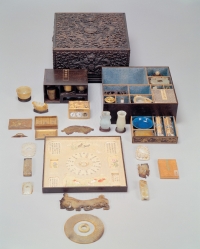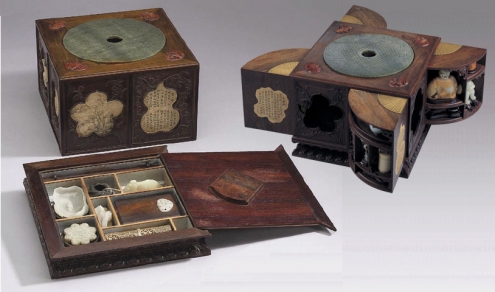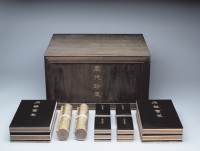|
Tags: Ching Dynasty | curio box | National Palace Museum
Introduction
Every museum has its unique historical background and compositional structure. The contents of a museum's collection and exhibits are dictated in part by such factors, and the objects in its holdings are important keys to understanding what makes that museum unique and different from others. In other words, regardless of any ensuing political or social changes that occur, this foundation of a collection can never be completely eradicated, because the only things that change are the perspective and interpretation.
The objects in the collection of the National Palace Museum were originally, for the most part, from the Ch'ing dynasty imperial court. The purpose of this exhibition is to represent the features of objects originally from the Ch'ing inner court. The display contents are divided into two major parts. The first is an image-based presentation with curio boxes on display. The reason for choosing this type of object is that curio boxes best symbolize the richness and diversity of the Ch'ing collection and at the same time exemplify the depth of culture and subtle aesthetics of daily life, offering viewers now (as in the past) an exciting and pleasurable experience. The second part is a more material-based presentation offering an assorted selection of objects that embodies the Chinese yearnings for inheritance and views emphasizing the transmission of collected works. It also deals with the origins of the Ch'ing court collection, conservation methods used, and various ways of attaching new meaning to collection objects. Finally, the exhibition also analyzes the different perspectives that have been taken and their levels of influence in terms of the imperial appreciation of objects and artworks, thus making for a total of four sections.
One of the objectives of this exhibition is to highlight more clearly the legacy behind and characteristics of much of the Museum collection. In addition, it is very much hoped that visitors who come to the Museum realize that these artifacts, once the exclusive private domain of the imperial family, have now been bestowed upon all people today for their common appreciation and universal admiration. Finally, after understanding the motivation for preserving these works in the past, it is desired that audiences nowadays will be likewise inspired to carry on this worthy tradition for future generations.
Passion for Collecting, Space for Amusement: The Art and Function of Curio Boxes
One of the most basic features of human nature and strongest of desires is that of possession and collecting. The problem is how to make the process of possessing varied and continuously interesting while also making the results of one's collecting uninhibited by spatial constraints. The production of "curio boxes" in the Ch'ing dynasty epitomizes the marshaling over the centuries of accumulated experiences in spatial management and clever techniques as well as the wisdom in and passion for daily life among scholars of the previous Ming dynasty. Not only did the latter pay attention to taste and logic in terms of their collections, they also added a playful innocence to their passion for collecting. The result is a small but complete world of play, a space for amusement that is full of twists and turns.
A rational collection is rooted in its structured storage format. Curio boxes represent distinctions of objects not only according to materials and forms, but also to standards of grading. This graded collection is evidenced by the fact that the most prized objects were stored in "curio boxes", while those of lesser grade were placed among "a hundred assorted items" and even further down in "treasure chests of ten thousand". In addition, curio boxes were often designed with certain effect in mind, allowing pieces to yield interaction with others or become reciprocally complementary. This method adds to the practical and convenient use of the limited space. It also gives the meaning of "combination' even more profound connotations that give equal consideration to material and spirit. The pragmatic and the emotions are both emphasized to accommodate a world within a world!
|

Square sandalwood curio box with cloud-and-dragon décor (containing 47 curios)
Ch'ien-lung era (1736-1795), Ch'ing Dynasty
H: 16.5 cm, W: 30.3 cm, L: 30.5 cm
National Palace Museum
|
One of the most attractive and unique features of curio boxes is the special attention placed on an "interest in playfulness". The design of a curio box is often prized for its clever construction, and surprising twists and hidden compartments are all part of the appreciation. In fact, the concept behind the curio box is somewhat akin to that of a "hide-and-seek" game, in which one is always discovering something new or surprising. So, if you are now ready for these "toy chests of the emperors", let's go!
 Square sandalwood curio case (containing 30 curios)
Square sandalwood curio case (containing 30 curios)
Ch'ien-lung era (1736-1795), Ch'ing Dynasty
H: 21 cm, W: 25 cm, L: 25 cm
National Palace Museum
Generations and Legacies: The Preservation and Collection of Artifacts
“May descendants forever treasure and cherish them" is a phrase expressing the hopes and dreams of the ancients when it came to family heirlooms, but these could never be realized if the objects were not collected, preserved, and repaired over the years. Archival documents of the Palace Workshop in the Ch'ing dynasty provide ample evidence of the court's meticulous conservation of its collections of cultural artifacts.
"Centralize and manage, distinguish and categorize" were the basic principles behind the systematic storage system. Consequently, artifacts of the same type were centrally managed on a massive scale. Not only were they divided and sorted according to a host of criteria that included their material and medium, function, and condition, they were also classified by age and authenticity into grades. Finally, there was the careful yet artistic task of packaging them. Collection pieces were also catalogued according to display or storage site. Notes concerning the objects were meticulously recorded and kept with the original packing.
As for the conservation of artifacts, metal wares were often "cleaned like new", while fragmentary jade pieces were not discarded by the court but instead often re-carved to give them a new function and appearance. As is well known, sometimes all that is necessary to give an old object new life is an accessory or two.
In the efforts of Ch'ing court collecting, the aspect most detailed and closest to the modern system used today was that of "artifact identification". The emperor relied on the cultivation and expertise of his literary officials and craftsmen to compile records and archives as well as launch research projects on these artworks, recording in detail their sizes and illustrating them in manuals.
 White porcelain dish with flaring rim and impressed design of prancing phoenixes
White porcelain dish with flaring rim and impressed design of prancing phoenixes
Ting ware, Sung-Yüan period
H: 2.2 cm, Diam: 22.5 cm
National Palace Museum |
 Wooden case with "Treasures of the Dynasties" (containing 20 jades)
Wooden case with "Treasures of the Dynasties" (containing 20 jades)
Ch'ien-lung era (1736-1795), Ch'ing Dynasty
H: 28.8 cm, W: 40 cm, L: 51.5 cm
National Palace Museum |
Visit website
|















